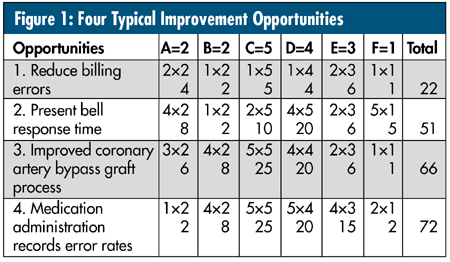One of the major causes of TQM and Six Sigma failures is selecting the wrong project. This selection is probably one of the most important decisions that management can make to support the improvement process.
There are many approaches that can be used to select projects. They range from management intuition to complex analyses of how the processes affect business opportunities. I will show you a weighted selection approach that is effective, using a health care example.
In this approach each opportunity is evaluated in a number of parameters. For example:
A) Changeability = 2 points
B) Reduce cost = 2 points
C) Decrease mortality = 5 points
D) Improve patient care = 4 points
E) Improve staff morale = 3 points
F) Reduce wait time = 1 point
Each of these parameters is weighted by a point score from one to five. A rating of one indicates that it’s low priority, and a rating of five indicates that it’s very high priority.

In figure 1, there are four typical improvement opportunities listed with the six parameters. Although only four improvement opportunities are listed, in reality the list could contain dozens. Some of the typical opportunities for a health care program include:
…
Comments
Add new comment